Indigo to Alaska
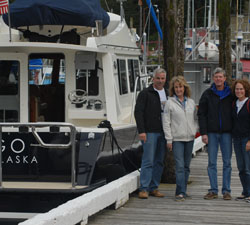
On a high-speed delivery to Whittier, Alaska, a brand-new Coastal Craft 400 IPS makes short work of the Inside Passage and the Gulf of Alaska.
In September 2010, I took a call from a pleasant Alaskan, Dick Weldin. I remember his genuine interest in boat design, the pros and cons of features, and his queries and speculation on craftsmanship―I enjoyed our call immensely. I extended an invitation to the upcoming Seattle Boat Show. Little did I suspect that a year later I would be at the Seattle show standing on Dick and wife Jennie’s new Coastal Craft 400 IPS Indigo. And I had no inclination that I would have the opportunity to crew for the Weldins on an amazing high-speed delivery to Whittier, Alaska.
When Dick and Jennie came aboard the Coastal Craft in Seattle things started to click right away. They are the founders of Weldin Construction in Palmer, Alaska. Their business attributes much of its success to the same principles that guide Coastal Craft. When they looked at the boat we had on display, they saw the attention to detail, how it was designed to be a superior sea boat and yet refined to the ultimate fit, finish and comfort. Dick and Coast Craft owner Jeff Rhodes bonded quickly; both are entrepreneurs who built businesses with a commitment to innovation and excellence.
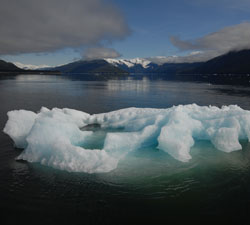 Soon after Indigo sold, in the midst of the largest economic downturn the boating industry had seen in decades, Coastal Craft sales grew. Requests for new and bigger models came rolling in at an unexpected rate. Jeff had to design new models, build infrastructure and deliver a boat to Alaska come spring. There were not enough hours in a day for him to do it all, and he had to make a difficult decision. A trip to Alaska was an adventure he would have loved, and his years of commercial experience running up the Inside Passage made him the perfect person to accompany the Weldins. But he needed to stay and manage production at Coastal Craft. Who could do the trip in his place? This sales guy raised his hand.
Soon after Indigo sold, in the midst of the largest economic downturn the boating industry had seen in decades, Coastal Craft sales grew. Requests for new and bigger models came rolling in at an unexpected rate. Jeff had to design new models, build infrastructure and deliver a boat to Alaska come spring. There were not enough hours in a day for him to do it all, and he had to make a difficult decision. A trip to Alaska was an adventure he would have loved, and his years of commercial experience running up the Inside Passage made him the perfect person to accompany the Weldins. But he needed to stay and manage production at Coastal Craft. Who could do the trip in his place? This sales guy raised his hand.
In my former work I captained a commercial boat, logging lots of open-ocean time and gaining experience few boaters obtain in a lifetime. I had the credentials, the Weldins graciously accepted, and I was honoured to be first crew of Indigo. But I was also terrified. Having the trip go any way but smoothly was not an option. I studied with a frenzy. I read guidebooks and talked to commercial fishermen and seasoned cruising guides.
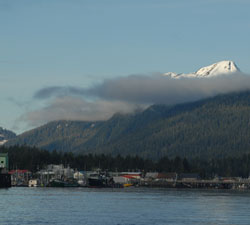 Trip Planning
Trip Planning
Our first decision was the departure date. My research suggested the best time to go was late May and early June, sooner than I would have thought. I learned that while later weather is warmer it comes with the addition of wind and fog, both substantial hazards to navigation.
Indigo is fast, really fast. She tops out at nearly 40 knots and holds a very economical 30-knot cruise. She can run at 16-24 knots in most seas. Drop her down to seven knots and she is stable and more economical than most trawlers. So we had the opportunity to cover major distances each day in a relatively fast trip.
I decided to divide the journey into 10 legs, mostly determined by reliable fuel stops. Some legs were the maximum distance we could do in a day, like the Gulf of Alaska; others were shorter to allow for weather, sightseeing, or unplanned events. In particular, we needed alternate plans for fuel stops and services in case of mishaps. I chose the Octopus Islands, Port McNeill, Shearwater Marina, Dundas Island or Foggy Bay, Petersburg, Tracey Arm, Juneau, Elfin Cove, Yakutat and Whittier as our stops.
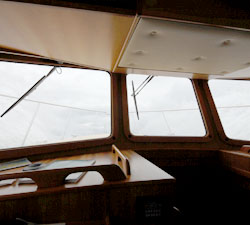 The next step was deciding which day to leave. Coastal Craft holds its annual owners rendezvous in late May each year at Poet’s Cove Resort at Bedwell Harbour. I thought this might be a fun time to launch for a couple reasons. The Weldins could attend the rendezvous and not have to fly back down a second time for the trip. And the buzz of a major expedition might get conversation going among rendezvous attendees. We also hoped to get some tips from some of our owners who were veterans of the Inside Passage.
The next step was deciding which day to leave. Coastal Craft holds its annual owners rendezvous in late May each year at Poet’s Cove Resort at Bedwell Harbour. I thought this might be a fun time to launch for a couple reasons. The Weldins could attend the rendezvous and not have to fly back down a second time for the trip. And the buzz of a major expedition might get conversation going among rendezvous attendees. We also hoped to get some tips from some of our owners who were veterans of the Inside Passage.
I shared my plan with those who had more experience and their reservations always revolved around the distance we aimed to travel in the time planned. I would listen to their questions and reassure them but not entirely address their disbelief that a boat could sustain travel at 30 knots. I knew the 400 IPS had an easy 30-knot cruise in good weather. What I did not know was the speed we would be able to sustain offshore. Only Mother Nature knew and we had to visit her to find out.
The rendezvous was fun and exciting. We had 17 Coastal Crafts attend along with three couples who had boats in production. The after-dinner conversation buzzed with excitement about the coming trip north. Indigo was on a fast track, and the 400 IPS A4SEA owned by Bernie and Beverly Fipp would accompany us up to Ketchikan.
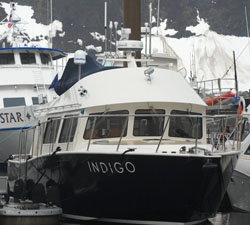 Sunday, May 20
Sunday, May 20
Saturday’s sunshine ran off with the sunset and Sunday greeted us with high clouds and light rain but no wind. After lunch, many goodbyes and well wishes, Indigo headed 33 miles to Bellingham to complete her first US Customs entry before heading north. The water was smooth in spite of the grey weather. We cleared US Customs effortlessly and re-entered Canada at Bedwell Harbour. We originally thought we would stay at Poet’s Cove for a night but we couldn’t overlook the day’s smooth water. We decided to meet A4SEA in Nanaimo, and the calm seas and light rain followed us all the way there. On our first day, we travelled nearly 170 miles.
Monday, May 21
The Halibut Bank weather buoy reported a calm Strait of Georgia, adding to my elevated mood. We left Nanaimo with more grey skies, light rain and calm winds. The “long way” through Desolation Sound and surrounding islands appealed as the route to Port McNeill. We wanted to see the sights and spend as little time as possible in Johnstone Strait, where the forecast was grim: gale-force winds. If the conditions were as bad as predicted we could fall back and anchor in the Octopus Islands.
The weather remained fine as we cruised at 30 knots past Desolation Sound, through the Yuculta Rapids and the whirlpools near Dent Island. Dick particularly enjoyed driving Indigo in the whirlpools. He has extensive river experience so it was fun for him to witness river hydraulics in the ocean. He could have played in the whirlpools all day!
Since the weather was cooperating, we pressed on. A little rain and chop arrived on our approach to Johnstone Strait but the weather tamed as we advanced. We ran the strait in mostly sunny conditions, some light rain, winds under 10 knots and no more than one-foot chop. We cruised comfortably into the Port McNeill fuel dock having covered nearly 180 miles at 30 knots all day. We finished the evening with a relaxing dinner at a Port McNeill pub.
The next leg of our journey, through Queen Charlotte Strait and around Cape Caution, would be our first open water. My research told me the forecast gale had passed us by and we had a good chance at calm weather tomorrow. We were also warned to watch the outgoing tide from the fjords and inlets around Cape Caution. If these significant outflows meet incoming wind and waves, it makes for a very dangerous situation. I double-checked the weather reports and they pointed to southeasterly conditions that should dampen the effects of this flow rather than jack it up. We decided to check in the morning―we could always turn back if the going was too rough.
Tuesday, May 22
I was a nervous boat hand, waking just before sunrise and anxious to get underway. The captain and first mate were comfortable in their forward suite and I was uncomfortable suggesting they get out of bed. Finally they woke to my fidgety sounds and our two 400 IPS Coastal Crafts were underway. Dick and Jennie made a point of telling me never to do that again; just wake them up, no need to be polite.
Queen Charlotte Strait was remarkably calm. A nice breeze at our backs pushed us out toward Cape Caution and the open ocean. Ten minutes seemed like 10 hours as I waited to get to the outflowing water. Thankfully, as I had hoped, the direction of the weather calmed the waves and currents and we were able to make our full cruising speed of 30 knots. It was a beautiful day to make the trip.
Our speed and economy were so good that we made a running call to pass our planned destination of Shearwater Marina near Bella Bella and push on to Prince Rupert, making it a 290-mile day. The speed and range of these vessels gave us many options for fuel and moorage, even in wilderness areas. We headed for Finlayson Channel to make a truly inside passage to Rupert, reaching it just as the fuel dock prepared to close. This was a lucky break since we wanted to get an early start to Dixon Entrance the next morning. Again, the weather was in our favor and it was our intention to make time while we could.
Wednesday, May 23
We all woke early to calm weather. Reports from the Central Dixon Entrance buoy suggested conditions should be favorable and we were underway by 0600 hours. We had wonderful weather and arrived at Ketchikan at 0800 Alaska Time. By the time we cleared US Customs A4SEA was tied up and ready to clear. The Fipps planned to stay in Ketchikan for a few days but we still had a great distance to cover. We exchanged friendly farewells and pushed on for Petersburg. Again, we had almost magical mirror-calm water as we cruised toward the Wrangell Narrows that lead to Petersburg. We arrived at 1330, much earlier than we stopped on previous days, but the next good spot for fuel was Juneau and that was too far to go today.
After dinner in town, we went over our next day’s plan. If the weather was good, we would go to Elfin Cove, a good place to fuel and launch into the Gulf of Alaska early the following day. We had easily done 200 miles this day and Elfin Cove was about the same distance away.
Thursday, May 24
I added Tracy Arm as a stop because I had heard it was a great place to see icebergs. I had never seen an iceberg and I was excited. Dick and Jennie were very kind to make this detour: since they live in northern Alaska, glaciers and icebergs aren’t a novelty. As we neared Tracy Arm I could see what looked like a fleet of boats outside the large bay. The white dots were not boats, but bergs. The hair on my neck stood straight up―I was so ecstatic that I did not notice Dick and Jennie yawning!
As we slowly moved into the fjord, more and more icebergs appeared, littering the horizon on glass-flat water. It was eerie, silent, graceful and majestic all at the same time. We idled around a couple of the largest icebergs and saw others beached on the rocks at low tide. Soon we were back on our way at 30 knots.
I realized we would arrive at Elfin Cove with enough daylight left to make it to Yakutat in the Gulf of Alaska. With the weather so good and daylight lasting till after 2200 I thought we should peek into the gulf. If it looked reasonable, we would make the 145-mile run to Yakutat tonight. The crew was ready to keep going and we were all anxious to get the gulf crossing behind us, so we stopped at Elfin Cove only for fuel.
The calmness was surreal. It looked as if we would make full speed but the farther we got out into the gulf the more seas we encountered. Not bad but enough to knock our speed down, first to 27 knots and then 20. There wasn’t much wind; a confused sea with swells from two different directions created the lump that slowed us down.
Not far out of Elfin Cove we got our first radio call from the only other small vessel we saw on our gulf crossing. It was St. Joseph, a 55’ commercial fish tender. He must have seen our AIS signal because he called us on the radio by our name and asked how we could be doing 27 knots in such sloppy seas. We asked him if he had heard a weather forecast. Unfortunately, he didn’t check them because he was going regardless. We wished him well and continued on into Yakutat.
There was no cell service in Yakutat so we used the satellite phone to call for fuel. The recording gave after-hours numbers and the first one I called was Jerome. At 2245pm he said, “Sure, I can bring fuel but there will be $100 surcharge.” We agreed to the price with appreciation. Jerome arrived in 20 minutes and we fueled. We asked him about the weather forecast and he relayed what he heard from the fishermen: the weather was turning tomorrow.
We crossed our fingers that we could get across the gulf before the weather turned. I had a weather expert I was waiting to use for this particular crossing. For a price he would give us a detailed professional analysis for our area. I did my calculations 100 times. We had 400 gallons of fuel; I considered 360 to be the maximum available. If we made similar speed and economy (20 knots at 23 gph) to today, we would be underway for 14.5 hours and use 335 gallons of fuel. That left 25 gallons in reserve. If the weather got rough and we slowed to 16 knots, our economy would drop. But hopefully we would make it across the gulf and into Prince William Sound before we had to drop our speed to seven knots to conserve fuel. In this scenario we would not arrive before nightfall and would be underway for 20 hours or more. The key was to make good time and good economy and it all depended on Mother Nature. We had done 360 miles that day and planned on nearly 300 the next. No grass was growing on Indigo’s bottom!
Friday, May 25
I called for our weather analysis as we idled out into Yakutat Bay. Bob’s report was clear, just as we had heard locally. The weather was good now but would turn later today. On our whole route we would encounter no more than five-foot seas and no more than 20 knots of wind. For the time being wind and waves were coming from the southeast (at our backs) but would turn to a less favorable westerly direction later that day. So we were underway for Whittier.
We had two routing options, around the north or south end of Kayak Island. The northern route was three miles shorter and would keep us in the lee of the island if the westerly came up. But the risks of its shallows and hazards were too great; we would go around the south end where the water was deep.
In the Gulf the seas appeared as we had seen them the night before: we had two swells at three to five feet coming from directions 90 degrees apart. This made the ocean lumpy and confused. Dick settled into a smooth, even 20-22-knot cruise that handled the seas quite well.
Not 30 minutes out of Yakutat we got another call from St. Joseph. He had been underway all night and was a bit behind us. Once we rounded the tip of Kayak Island (about halfway across) we would see if the weather changed and could make a decision to turn around there. Once we committed at that point there was no turning back.
About two hours before Kayak Island we got a satellite call from Jeff. “How’s the weather?” he asked with obvious concern. I said it was amazing, five-foot waves and under, and less than 15 knots of wind, but we had this stubborn westerly swell that Bob had not forecast. This swell slowed us down. Jeff got serious: “I have seen some buoy reports and forecasts that are calling for a gale in your area. If I was you I would not have gone this morning.”
The weather here was exceptionally good. Based on all of my years of offshore work, the idea that we would experience gale conditions in a few hours simply did not ring true. I asked Jeff to call Bob with this data and see what they came up with together. We still had time to turn around but my sense was that we had picked the weather perfectly and now was the time to go. Jeff thought we should stay closer to shore, that the weather would be better; he recommended we round the north end of Kayak Island. He promised to call Bob and get back to me.
Jeff was an accomplished seaman and I took his advice seriously. Dick and I looked over the charts again. We had the same take: too shallow, too close to shore and possibly breakers. I’ll choose big seas and wind in deep water over shore break and rocks any day. We decided to stay on course for the south end. Jeff phoned after talking to Bob to say it was looking better but we would likely experience 20-knot winds before we entered Prince William Sound. That I could handle. I relaxed a bit and got back to helping Dick look for debris.
With Dick and I both paying full attention in the confused seas, we were surprised by our first hit. We heard a solid thunk against the aluminum hull, then lighter bumps as the unseen object worked its way back to our perfectly-honed nibral props. There was nothing to do but hope the design of the boat―with skegs well in front the IPS drives to deflect debris―did what it was intended to do. Whatever it was, the object spared us any damage; the skegs likely pushed the debris down and under our precious props.
Not long after the near-miss, the Hinchinbrook Entrance to Prince William Sound came into view. We had made it. Around 1730, we entered Hinchinbrook Entrance. We were over 12 hours underway and we had another hour-and-a-half to go. Once inside the entrance you are protected from the swells. It was awesome to see the islands and coastline of Prince William Sound. There are endless coves, glaciers and bays to explore. What a boating paradise!
Our destination of Whittier had initially been a military base but was now a very small town. I was in a sort of shock: we had made it safely. None of the crews on vessels we saw coming in and out of the harbor could possibly understand how far and how fast we had come. We got Indigo settled in and headed over to the local lodge for dinner and a celebratory cocktail.
The next morning, Jennie showed me the local newspaper. It had a picture of St. Joseph on her side on a beach with her cargo strewn about. She lost her steering in 20-foot seas and the crew of five was evacuated by helicopter. St. Joseph was about six hours behind us. It was shocking to read of her experience in such terrible conditions. I took note of my earlier feelings that the weather couldn’t possibly change so quickly. Again, we felt very fortunate to have made it safely.
The Weldins are truly exceptional people who commissioned a truly extraordinary vessel in Indigo. They have just begun to experience the new adventures that Indigo will enable them to have. I was honored to have the opportunity to help them to get Indigo home.
Bellingham, Washington to Whittier, Alaska
Approximate total miles traveled: 1,500
Day 1 Bellingham-Nanaimo 170 miles
Day 2 Nanaimo-Port McNeill 180 miles
Day 3 Port McNeill-Prince Rupert 290 miles
Day 4 Prince Rupert-Petersburg 200 miles
Day 5 Petersburg-Yakutat 360 miles
Day 6 Yakutat to Whittier 300 miles
Average Fuel Consumption: .9 mpg
Average Speed: 27 knots
Spray that hit Windows: None
Indigo
Coastal Craft 400 IPS
LOA 43’
Beam 14
Draft 3’ 6”
Displacement (loaded) 31,500 lbs
Propulsion Twin Volvo IPS600 Drives
Engines Twin Volvo D6-435 Diesels
Maximum Speed 37 knots
Maximum Cruise 30 knots
PHOTO CAPTIONS:
Photo 1: Indigo’s owners, Dick and Jennie Weldin, with Bernie and Beverly Fipp, owners of A4SEA, before departure from Poet’s Cove Resort, South Pender Island.
Photo 2: Ice was everywhere in Tracy Arm―it made for a magical sight.
Photo 3: Our fair weather held as we left Petersburg, Alaska.
Photo 4: Indigo sheds water in a big sea – not a drop on the windshield.
Photo 5: Indigo safely home in Whittier, Alaska.
Story & Photos by Brian Krantz




























